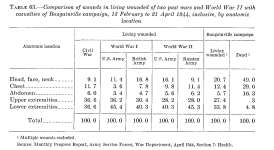Here is an analysis of wound location put out by the US Army Medical Corps.
View attachment 3684
I found the document that includes the table above. You can find here:

collections.nlm.nih.gov
The document includes the actual number of wounds incurred, as you can see below:
| Bougainville Campaign | | | | |
| Anatomic Location | Living Wounded | Dead | Wounded
& Dead | Lethality (% Dead) |
| Head, Face, Neck | 240 | 144 | 384 | 37.5% |
| Chest | 144 | 87 | 231 | 37.7% |
| Abdomen | 66 | 48 | 114 | 42.1% |
| Upper Extremities | 319 | 1 | 320 | 0.3% |
| Lower Extremities | 393 | 14 | 407 | 3.4% |
| Total Number | 1162 | 294 | 1456 | 20.2% |
| Total % | 80% | 20% | 100% | |
Note: These figures do not include wounds to multiple locations (332 total, 101 dead), and they do not include minor wounds treated at aid station and immediately returned to duty (total 547).
As can be seen, the dead make up about 20% of total casualties, and as BackworldTraveller noted, lethality for head, chest, and abdomen is very high, around 40%. Extremity wounds rarely lead to death.
Looking at percentage breakdowns, as a simple approximation, head wounds make up about 25% of total, torso about 25%, arms and legs each about 25% (perhaps useful for a simple allocation of hit location? (e.g. serious damage 50% to head, 50% to torso, minor damage 50% to arms, 50% to legs)
| Anatomic Location | Living Wounded | Dead | Wounded
& Dead | Simple Approx. |
| Head, Face, Neck | 20.7% | 49.0% | 26.4% | 25.0% |
| Chest | 12.4% | 29.6% | 15.9% | 25.0% |
| Abdomen | 5.7% | 16.3% | 7.8% | Included with Chest |
| Upper Extremities | 27.5% | 0.3% | 22.0% | 25.0% |
| Lower Extremities | 33.8% | 4.8% | 28.0% | 25.0% |
| Total % | 100.0% | 100.0% | 100.0% | 100.0% |

